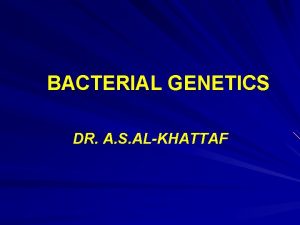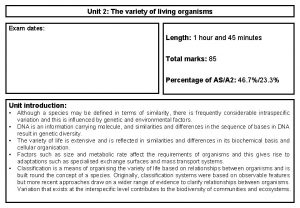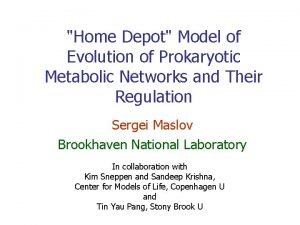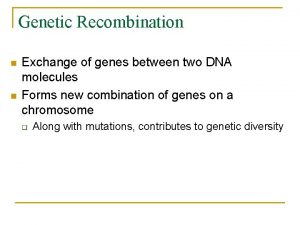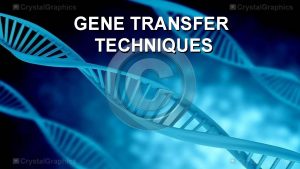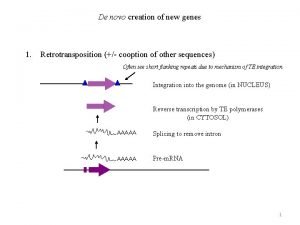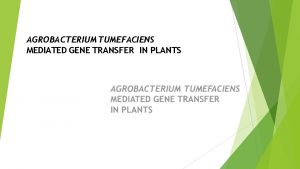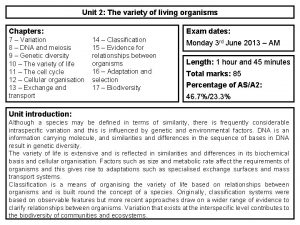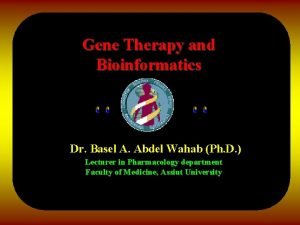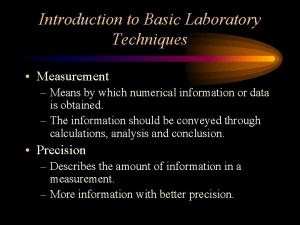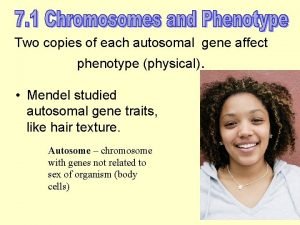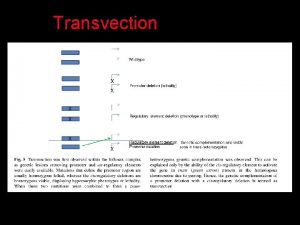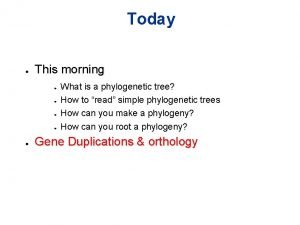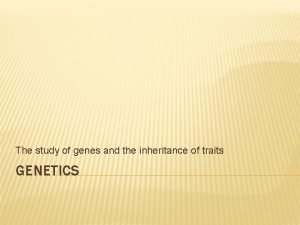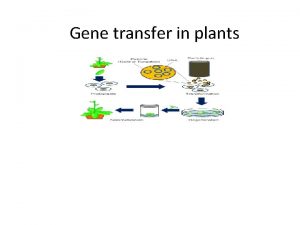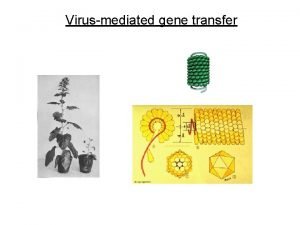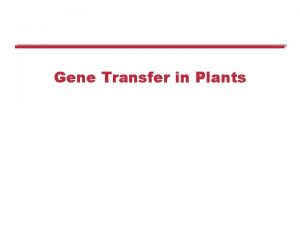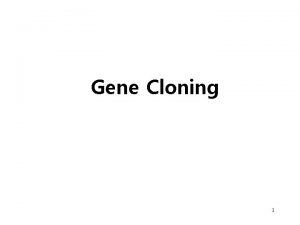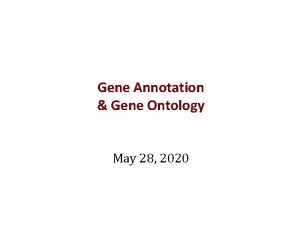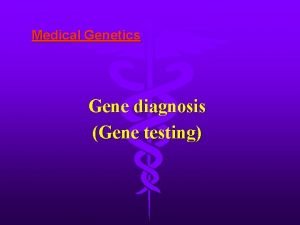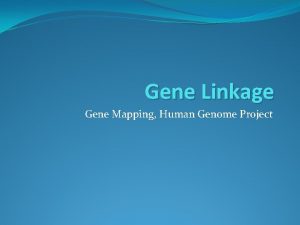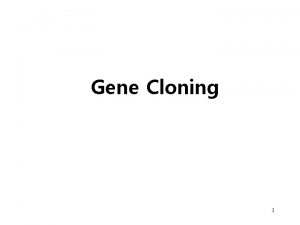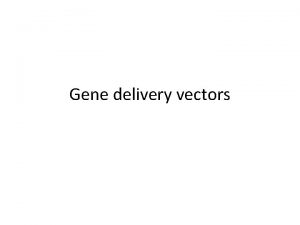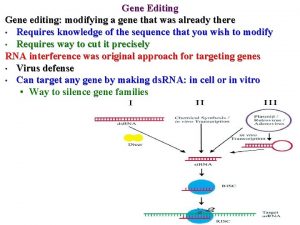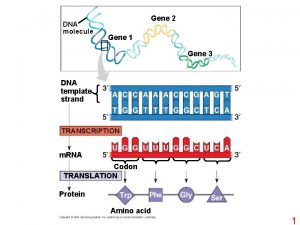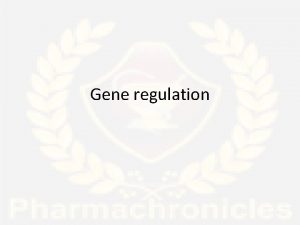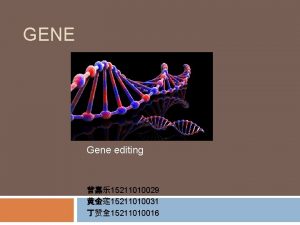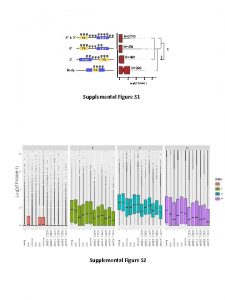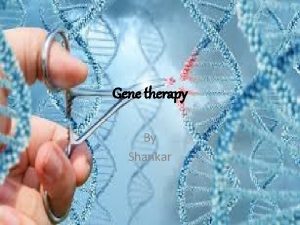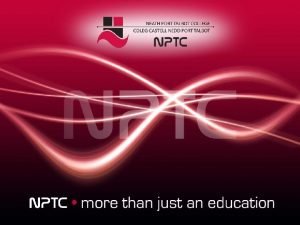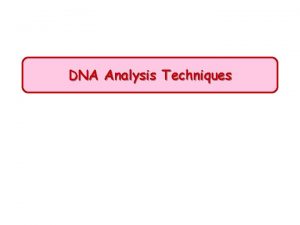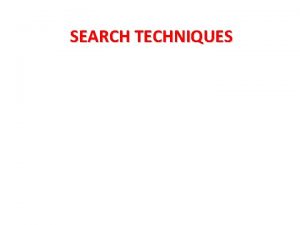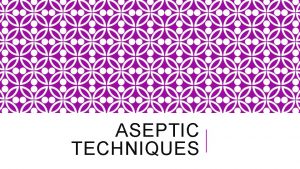GENE TRANSFER TECHNIQUES INTRODUCTION Gene transfer is to


































- Slides: 34

GENE TRANSFER TECHNIQUES

INTRODUCTION • Gene transfer is to transfer a gene from one DNA molecule to another DNA molecule. • The directed desirable gene transfer from one organism to another and the subsequent stable integration & expression of foreign gene into the genome is referred as genetic transformation. • Transient transformation occur when DNA is not integreted into host genome

• Stable transformation occur when DNA is integrated into host genome and is inherited in subsequent generations. • The transferred gene is known as transgene and the organism that develop after a successful gene transfer is known as transgenic.

METHODS OF GENE TRANSFER DNA transfer by natural methods • 1. Conjugation • 2. Bacterial transformation • 3. Retroviral transduction • 4. Agrobacterium mediated transfer

DNA TRANSFER BY ARTIFICIAL METHODS • • Physical methods 1. Microinjection 2. Biolistics transformation Chemical methods 1. DNA transfer by calcium phosphate method 2. Liposome mediated transfer Electrical methods 1. Electroporation

CONJUGATION • Requires the presence of a special plasmid called the F plasmid. • Bacteria that have a F plasmid are referred to as as F+ or male. Those that do not have an F plasmid are F- of female. • The F plasmid consists of 25 genes that mostly code for production of sex pilli. • A conjugation event occurs when the male cell extends his sex pilli and one attaches to the female.

• This attached pilus is a temporary cytoplasmic bridge through which a replicating F plasmid is transferred from the male to the female. • When transfer is complete, the result is two male cells. • When the F+ plasmid is integrated within the bacterial chromosome, the cell is called an Hfr cell (high frequency of recombination cell).


TRANSFORMATION • transformation is the direct uptake of exogenous DNA from its surroundings and taken up through the cell membrane. • Transformation occurs naturally in some species of bacteria, but it can also be effected by artificial treatment in other species. • Cells that have undergone this treatment are said to be competent. • Any DNA that is not integrated into he chromosome will be degraded.


TRANSDUCTION • Gene transfer from a donor to a recipient by way of a bacteriophag. . • If the lysogenic cycle is adopted, the phage chromosome is integrated (by covalent bonds) into the bacterial chromosome, where it can remain dormant for thousands of generation • The lytic cycle leads to the production of new phage particles which are released by lysis of the host.


AGROBACTERIUM MEDIATED TRANSFER • Agrobacterium tumefaciens is a soil borne gram negative bacterium. • It invades many dicot plants when they are injured at the soil level and causes crown gall disease. • The ability to cause crown gall disease is associated with the presence of the Ti (tumour inducing) plasmid within the bacterial cell. • Ti plasmid can be used to transport new genes into plant cells.

THE Ti-PLASMIDS • A remarkable feature of the Ti plasmid is that, after infection, part of the molecule is integrated into the plant chromosomal DNA. • This segment, called the T-DNA, is between 15 and 30 kb in size, depending on the strain. • T-DNA contains eight or so genes that are expressed in the plant cell and are responsible for the cancerous properties of the transformed cells. • These genes also direct synthesis of unusual compounds, called opines, that the bacteria use as nutrient.

• The vir (virulence) region of the Ti- plasmid contains the genes required for the T-DNA transfer process. • The genes in this region encode the DNA processing enzymes required for excision, transfer and integration of the T-DNA segment.

• The T-DNA region of any Ti plasmid is defined by the presence of the right and the left border sequences. • These border sequences are 24 bp imperfect repeats. • Any DNA between the borders will be transferred in to the genome of the plant.

Ti-Plasmid mediated transfer of gene into a plant • The Ti-Plasmid has an innate ability to transmit bacterial DNA into plant cells. • The gene of a donor organism can be introduced into the Ti plasmid at the T-DNA region • This plasmid now becomes a recombinant plasmid. • By Agrobacterium infection, the donor genes can transferred from the recombinant Ti- Plasmid and integrated into the genotype of the host plant.

• • • VECTORLESS or DIRECT GENE TRANSFER Physical methods 1. Microinjection 2. Biolistics transformation Chemical methods 1. DNA transfer by calcium phosphate method 2. Liposome mediated transfer 3. Transfer of DNA by use of polyethene glycol Electrical methods 1. Electroporation

Electroporation • Electroporation uses electrical pulse to produce transient pores in the plasma membrane thereby allowing DNA into the cells. • These pores are known as electropores. •

• The cells are placed in a solution containing DNA and subjected to electrical pulse to cause holes in the membrane. • The foreign DNA fragments enter through holes into the cytoplasm and then to nucleus.

Advantages of Electroporation • 1. Method is fast. • 2. Less costly. • 3. Applied for a number of cell types. • 4. Simultaneously a large number of cell can be treated. • 5. High percentage of stable transformants can be produced

Microinjection The microinjection is the process of transferring the desirable DNA into the living cell , through the use of glass micropipette. Glass micropipette is usually of 0. 5 to 5 micrometer, easily penetrates into the cell membrane and nuclear envelope. The desired gene is then injected into the sub cellular compartment and needle is removed


Limitations of microinjection • Costly. • Skilled personal required. • More useful for animal cells.

Biolistics or Microprojectiles • Biolistics or particle bombardment is a physical method that uses accelerated microprojectiles to deliver DNA or other molecules into intact tissues and cells. • The gene gun is a device that literally fires DNA into target cells. • The DNA to be transformed into the cells is coated onto microscopic beads made of either gold or tungsten.

• The coated beads are then attached to the end of the plastic bullet and loaded into the firing chamber of the gene gun. • An explosive force fires the bullet with DNA coated beads towards the target cells that lie just beyond the end of the barrel. • Some of the beads pass through the cell wall into the cytoplasm of the target cells


Liposome mediated gene transfer • Liposomes are spheres of lipids which can be used to transport molecules into the cells. • These artificial vesicles that can act as delivery agents for exogenous materials including transgenes. • Promote transport after fusing with the cell membrane. • Cationic lipids are those having a positive charge are used for the transfer of nucleic acid.

Advantages • • 1. Simplicity. 2. Long term stability. 3. Low toxicity. 4. Protection of nucleic acid from degradation

Calcium phosphate mediated DNA transfer • The process of transfection involves the admixture of isolated DNA (10 -100 ug) with solution of calcium chloride and potassium phosphate so precipitate of calcium phosphate to be formed. • Cells are then incubated with precipitated DNA either in solution or in tissue culture dish. • A fraction of cells will take up the calcium phosphate DNA precipitate by endocytosis.

• Transfection efficiencies is quite low.

Polyethylene glycol mediated transfection • This method is utilized for protoplast only. • Polyethylene glycol stimulates endocytosis and therefore DNA uptake occurs. • Protoplasts are kept in the solution containing polyethylene glycol (PEG). • After transfer of DNA to the protoplast in presence of PEG and other chemicals, PEG is allowed to get removed

SCREENING OF TRANSGENE • The presence of transgene or gene of interest is detected by several methods: • A selectable marker gene • Southern blot techniques • Northern bolt technique • Western blot technique

APPLICATION • • Clinical gene transfer applications Vaccine Development Production of transgenic animals Treatment of Cancer, AIDS Gene Discovery Gene Therapy Enhancing the resistance of plants GMO
 Gene by gene test results
Gene by gene test results Chapter 17: from gene to protein
Chapter 17: from gene to protein Vertical gene transfer
Vertical gene transfer Vertical gene transfer
Vertical gene transfer Horizontal gene transfer
Horizontal gene transfer Blood vessel
Blood vessel Horizontal gene transfer
Horizontal gene transfer How to explain
How to explain Horizontal gene transfer
Horizontal gene transfer Gene transfer by electroporation
Gene transfer by electroporation Horizontal gene transfer
Horizontal gene transfer Vertical gene transfer
Vertical gene transfer Agrobacterium mediated gene transfer
Agrobacterium mediated gene transfer Vertical gene transfer
Vertical gene transfer Horizontal gene transfer
Horizontal gene transfer Horizontal gene transfer
Horizontal gene transfer Fonctions et solutions techniques
Fonctions et solutions techniques Plain folks persuasive technique
Plain folks persuasive technique Persuasive technique bandwagon
Persuasive technique bandwagon Transfer persuasive technique examples
Transfer persuasive technique examples Example of
Example of Knowledge transfer techniques
Knowledge transfer techniques A wave is a disturbance that transfers
A wave is a disturbance that transfers Basic laboratory techniques introduction
Basic laboratory techniques introduction Introduction to sql programming techniques
Introduction to sql programming techniques Introduction to sql programming techniques
Introduction to sql programming techniques Mass transfer formula
Mass transfer formula Mass transfer
Mass transfer Intro paragraph outline
Intro paragraph outline Growner definition
Growner definition Difference between autosomes and sex chromosome
Difference between autosomes and sex chromosome Hox gene mutation in drosophila
Hox gene mutation in drosophila Species tree
Species tree Are brown eyes dominant over green
Are brown eyes dominant over green Gene aitken
Gene aitken



